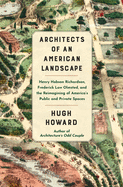
Upon finishing Architects of an American Landscape: Henry Hobson Richardson, Frederick Law Olmsted, and the Reimagining of America's Public and Private Spaces, readers may be inclined to add Richardson's and Olmsted's names to the list of history's great odd couples. Hugh Howard has written a stirring dual biography, documenting how his diametrically opposed subjects' collaborations throughout their two-decade friendship yielded era-defining and enduringly influential design work.
Raised in Hartford, Conn., landscape designer Frederick Law Olmsted (1822-1903) was a pragmatist, an autodidact and an occasional depressive who saw his work on public parks--first and most famously Central Park--as a democratic imperative. Architect Henry Hobson Richardson (1838-1886), a wealthy son of New Orleans, was an École des Beaux Arts-educated, apolitical dreamer given to overindulgence. The two never formed an official partnership, but through their joint efforts on libraries, rail stations, a psychiatric hospital and other commissions, the friends, in Howard's words, "employed the gifts of nature and their innate passion for beauty to redefine the country's rapidly changing landscape."
While Olmsted's name remains well-known, Richardson, whose taste for open plans and shingling were major influences on domestic architecture, has been largely forgotten outside architect circles. In his acknowledgments, Howard (Mr. and Mrs. Madison's War) writes of his hope that his book will "help bring Richardson back into the mainstream conversation." The text of Architects of an American Landscape gives readers much to discuss, as do the book's several dozen illustrations, which include architectural plans that are works of art unto themselves. --Nell Beram, author and freelance writer

